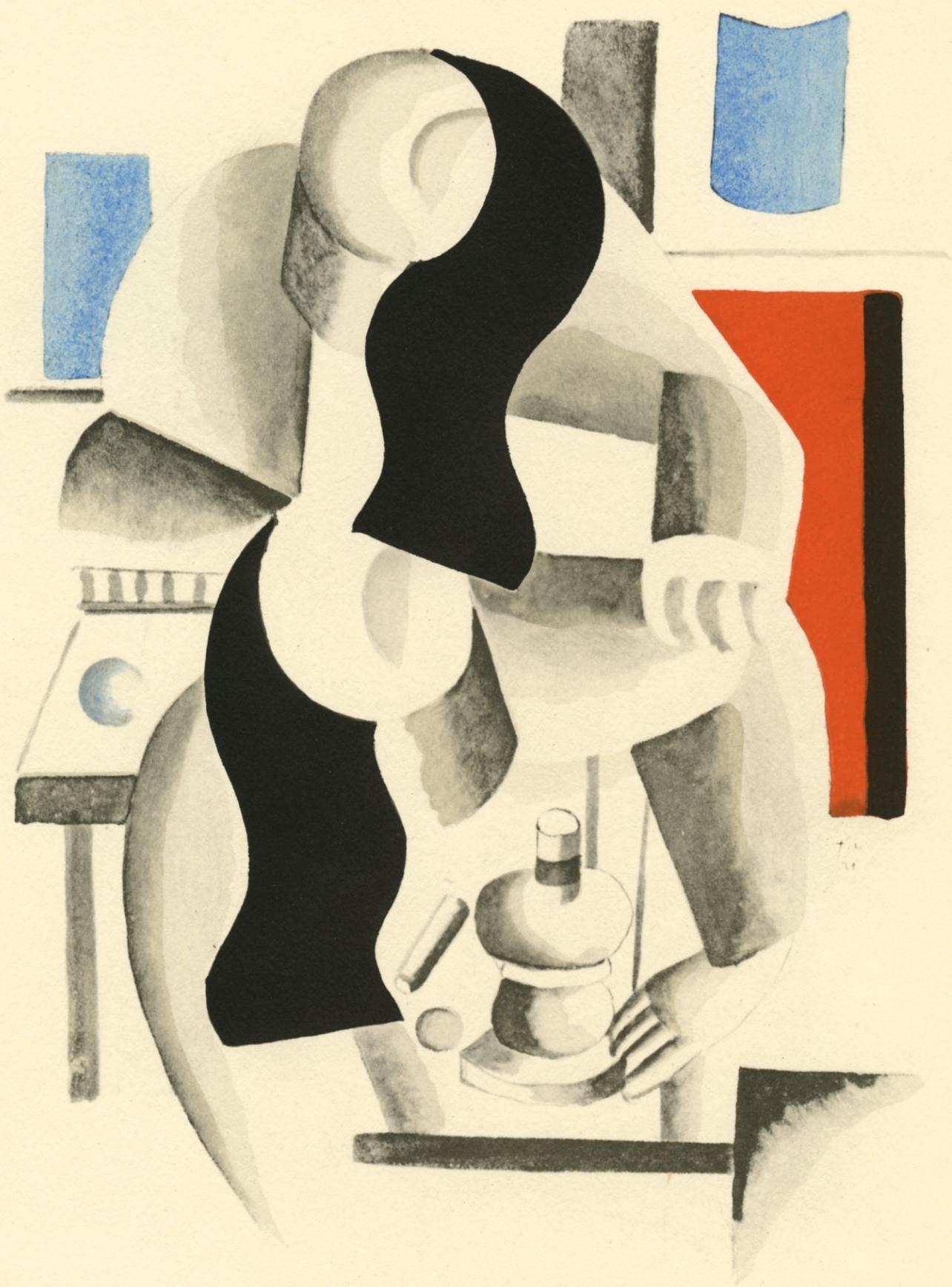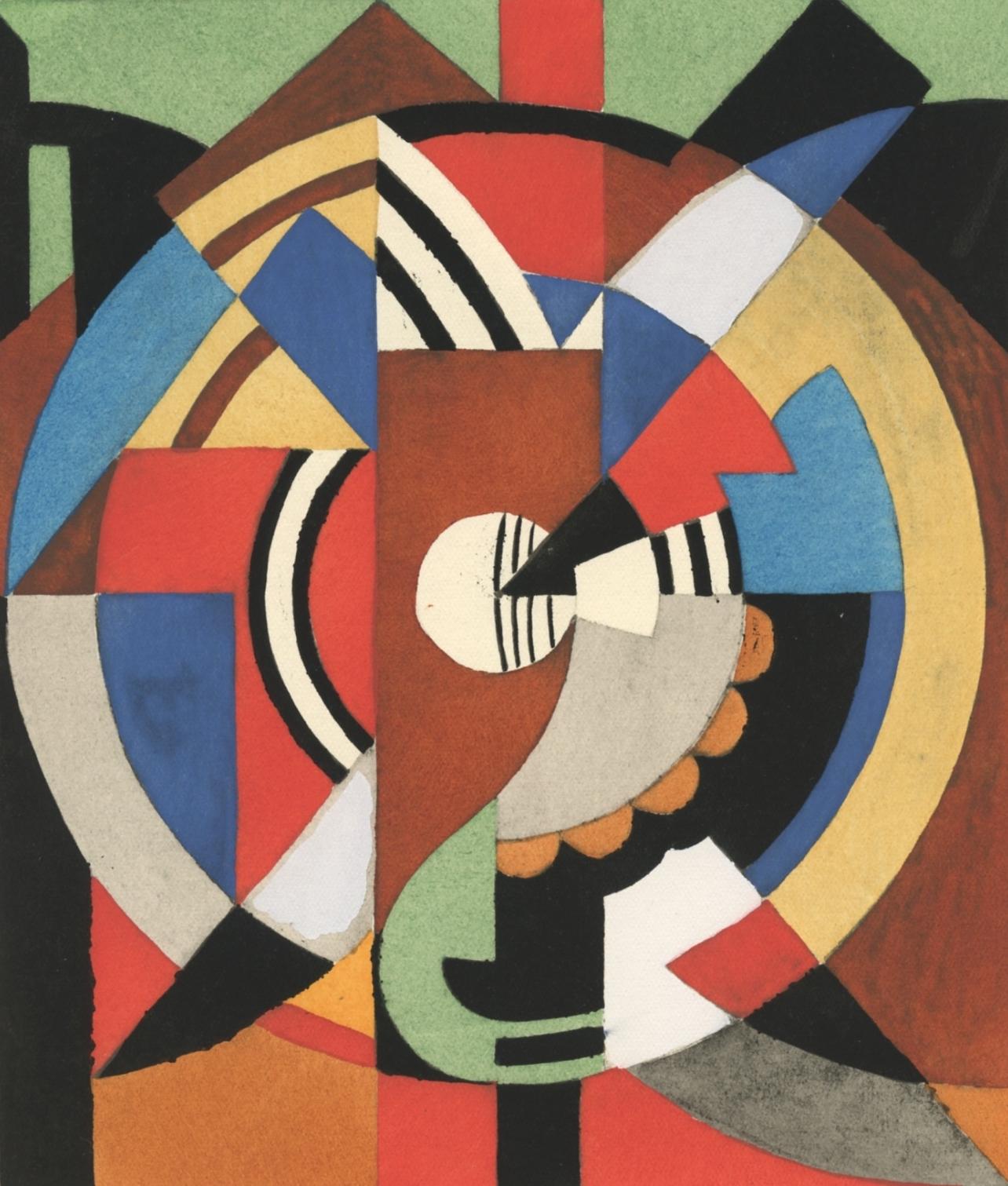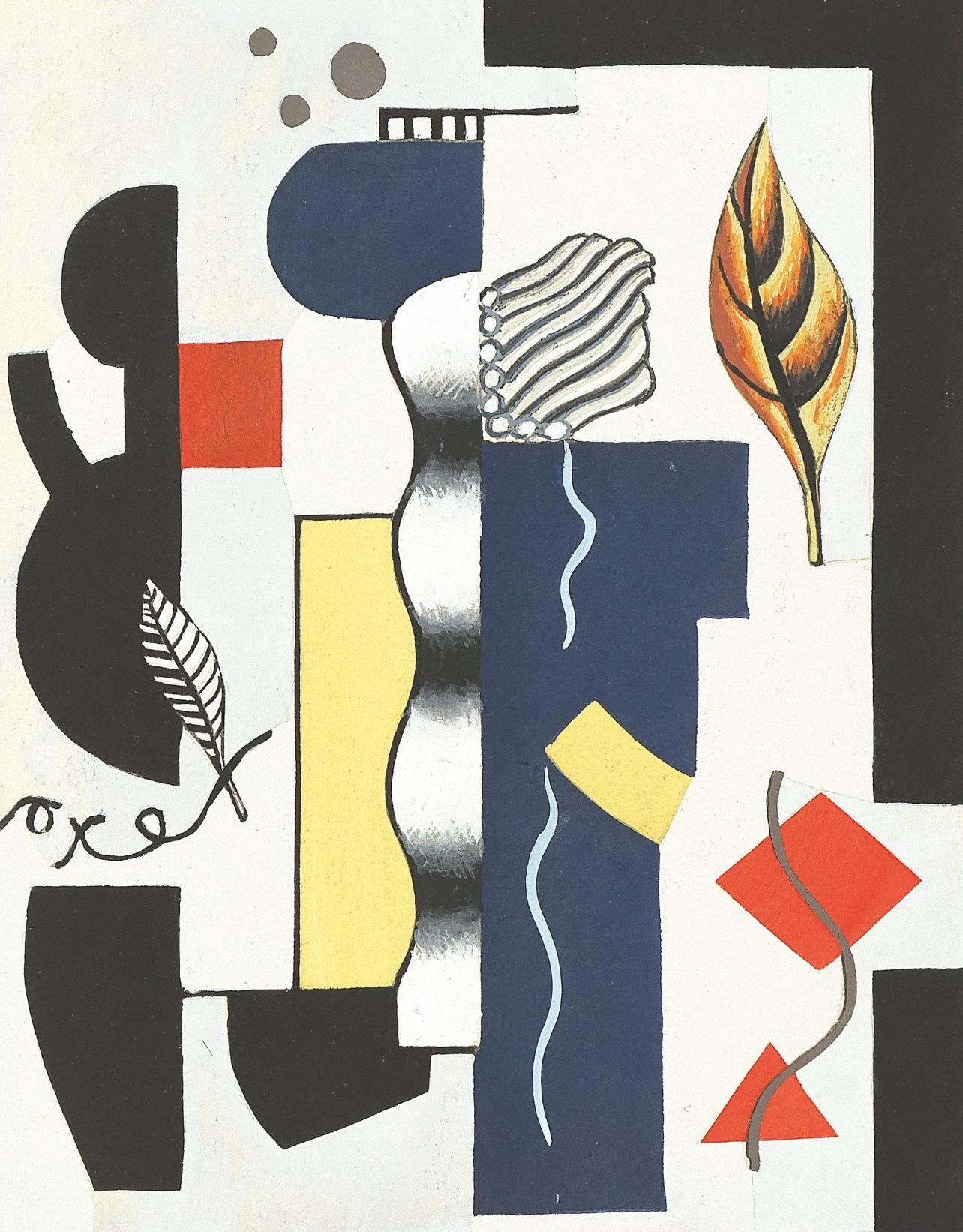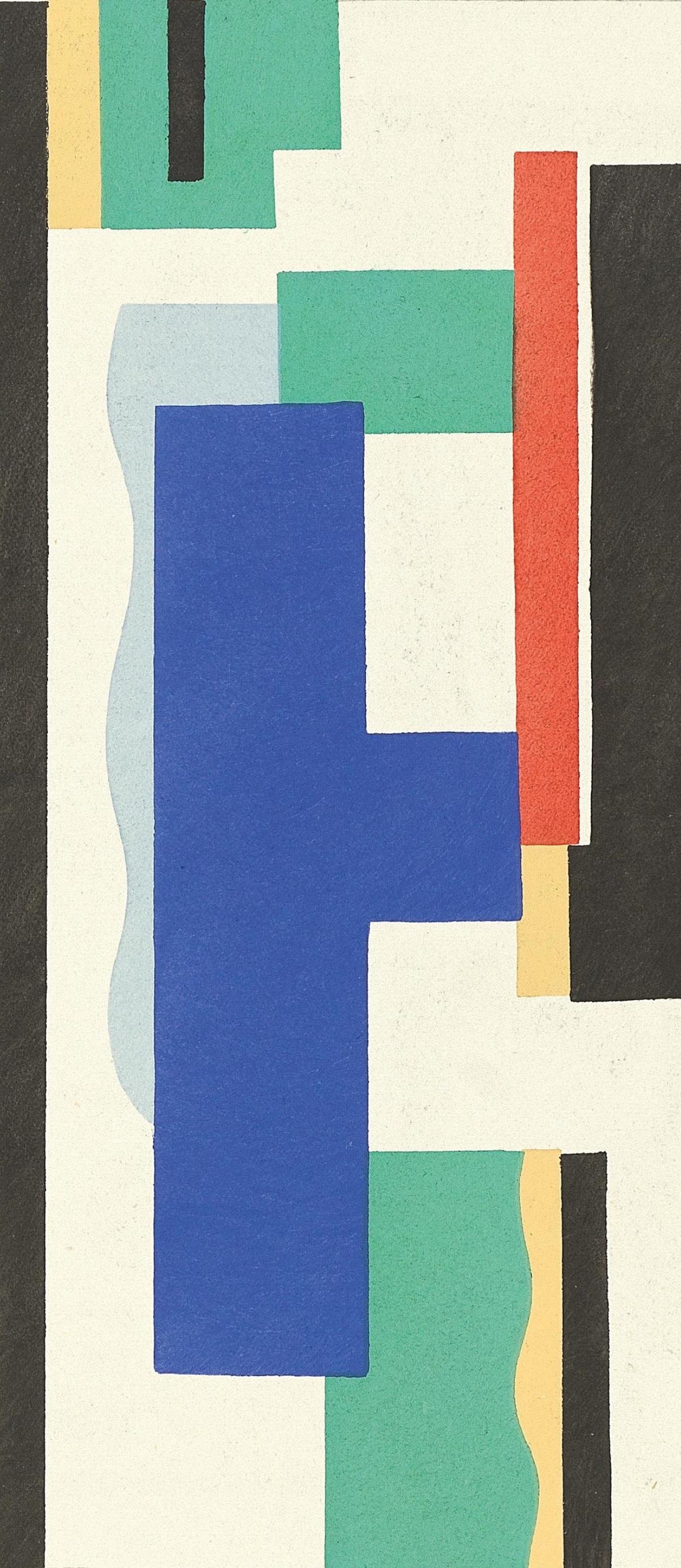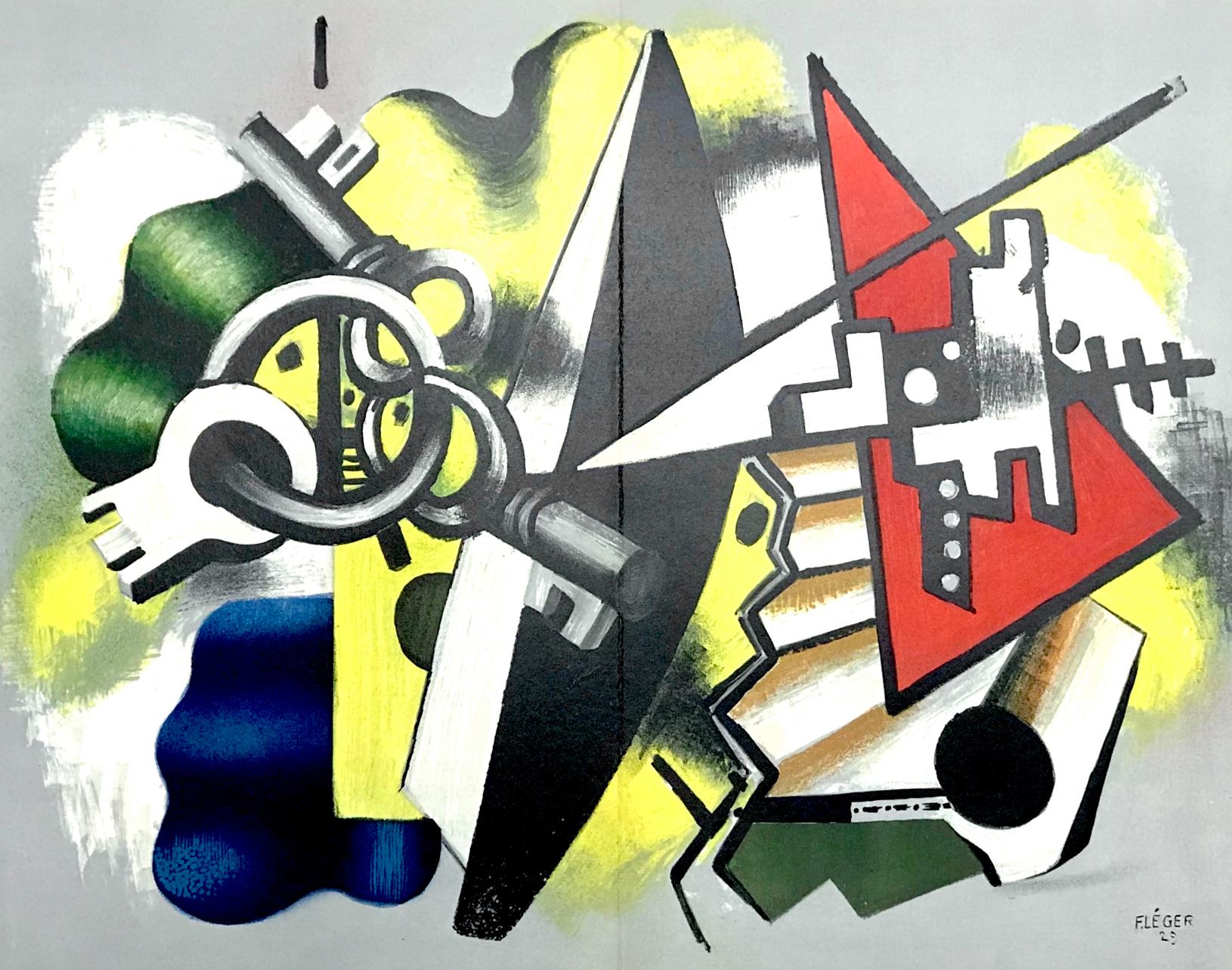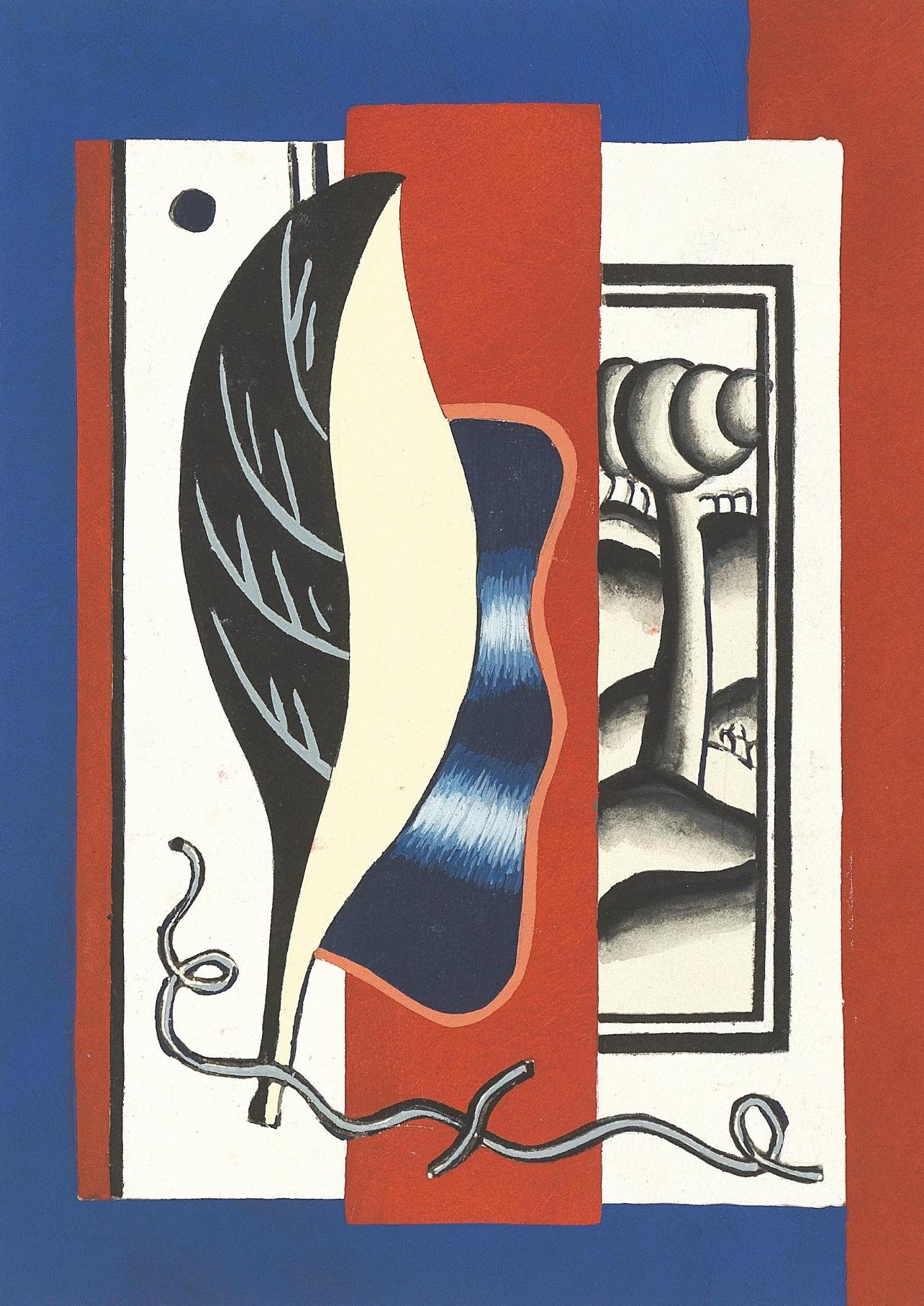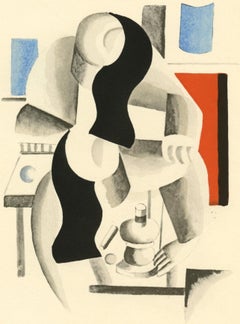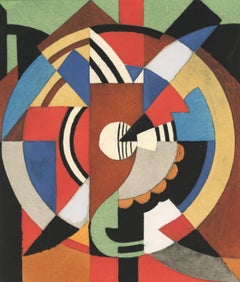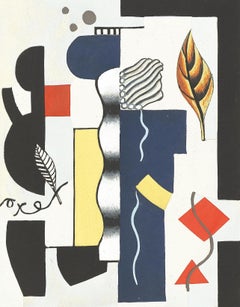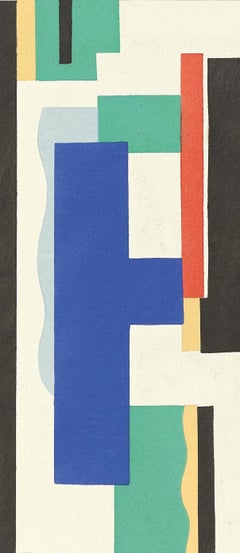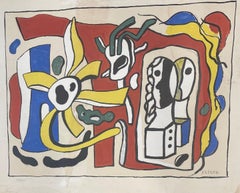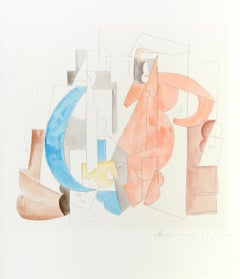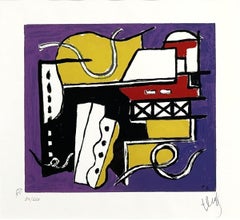Items Similar to Fernand Leger, Mechanical Elements, 1929 (after)
Want more images or videos?
Request additional images or videos from the seller
1 of 6
Fernand Leger, Mechanical Elements, 1929 (after)1929
1929
$1,916
$2,39520% Off
£1,489.18
£1,861.4820% Off
€1,698.01
€2,122.5120% Off
CA$2,748.97
CA$3,436.2120% Off
A$2,992.33
A$3,740.4120% Off
CHF 1,581.91
CHF 1,977.3920% Off
MX$36,180.76
MX$45,225.9520% Off
NOK 19,830.89
NOK 24,788.6120% Off
SEK 18,561.68
SEK 23,202.1020% Off
DKK 12,676.58
DKK 15,845.7320% Off
About the Item
This exquisite lithograph and pochoir after Fernand Leger (1881–1955), titled Elements mecaniques (Mechanical Elements), from the album L'Art Cubiste, Theories et Realisations, Etude Critique (Cubist Art, Theories and Achievements, Critical Study), originates from the 1929 edition published by Editions Charles Moreau, Paris, and printed by Atelier Daniel Jacomet, Paris, May 1929. Elements mecaniques (Mechanical Elements) exemplifies Leger’s pioneering fusion of modern industry and Cubist abstraction, translating the dynamism of machinery into a visual symphony of form, rhythm, and color. Through interlocking cylinders, gears, and mechanical motifs, the composition celebrates the harmony between human ingenuity and technological progress. Executed with both structural precision and lyrical energy, this work reflects Leger’s belief that art should mirror the vitality of the machine age—mechanical yet deeply human, analytical yet poetic.
Executed as a lithograph and pochoir on velin paper, this work measures 10.83 x 8.27 inches. Signed in the plate and unnumbered as issued. The edition exemplifies the exceptional craftsmanship of Atelier Daniel Jacomet, Paris, under the direction of Editions Charles Moreau, Paris.
Artwork Details:
Artist: After Fernand Leger (1881–1955)
Title: Elements mecaniques (Mechanical Elements), from the album L'Art Cubiste, Theories et Realisations, Etude Critique (Cubist Art, Theories and Achievements, Critical Study), 1929
Medium: Lithograph and pochoir on velin paper
Dimensions: 10.83 x 8.27 inches (27.5 x 21 cm)
Inscription: Signed in the plate and unnumbered as issued
Date: May 1929
Publisher: Editions Charles Moreau, Paris
Printer: Atelier Daniel Jacomet, Paris
Condition: Well preserved, consistent with age and medium
Provenance: From the album L'Art Cubiste, Theories et Realisations, Etude Critique, published by Editions Charles Moreau, Paris, and printed by Atelier Daniel Jacomet, Paris, May 1929
Notes:
Excerpted from the album (translated from French): This album was composed in Didot Characters and completed to print in May 1929 by Ducros et Colas, Maitres-Imprimeurs in Paris. Boards have been executed by D. Jacomet in an edition of D examples, numbered on the colophons.
About the Publication:
L'Art Cubiste, Theories et Realisations, Etude Critique (Cubist Art, Theories and Achievements, Critical Study), published in 1929 by Editions Charles Moreau, stands as a landmark in the history of modern art publishing and one of the most refined homages to the Cubist movement. Bringing together theoretical essays and a portfolio of color plates by its leading innovators—including Pablo Picasso, Georges Braque, Juan Gris, Fernand Leger, Albert Gleizes, Andre Lhote, Louis Marcoussis, Auguste Herbin, Georges Valmier, and Henri Laurens—the album presented both the intellectual foundations and the aesthetic diversity of Cubism. Each plate was printed in lithography and finished by hand in pochoir by Daniel Jacomet, whose craftsmanship preserved the chromatic richness and structural clarity of the original works. The project remains a definitive expression of the dialogue between theory, color, and form that defined early 20th-century abstraction.
About the Artist:
Fernand Leger (1881–1955) was a visionary French painter, sculptor, designer, and filmmaker whose groundbreaking fusion of modern industry, vivid color, and geometric form transformed the course of 20th-century art. Born in Argentan, Normandy, Leger began as an architectural draftsman before studying at the Academie Julian and the Ecole des Beaux-Arts in Paris, where he absorbed the lessons of Paul Cezanne’s structural rigor and the revolutionary ideas of Cubism. Alongside Pablo Picasso and Georges Braque, he became one of the leading innovators of the avant-garde, yet his work stood apart through its embrace of mechanical rhythm, bold contrasts, and industrial modernity—earning him the title “the painter of the machine age.” His art celebrated the beauty of technology, urban life, and the human form rendered in dynamic, interlocking cylinders and planes, evoking the pulse of the modern world. Immersed in the vibrant Parisian art scene, Leger worked in dialogue with peers and contemporaries such as Alexander Calder, Alberto Giacometti, Salvador Dali, Joan Miro, Wassily Kandinsky, Marcel Duchamp, and Man Ray, all of whom shared his commitment to innovation and the reimagining of artistic expression. Beyond painting, Leger’s creative reach extended into film, design, and monumental public art—his 1924 collaboration on Ballet Mecanique with Dudley Murphy and Man Ray remains a landmark of avant-garde cinema. His later works evolved toward greater clarity and monumentality, celebrating the unity of form, color, and humanity through large-scale murals and mosaics that bridged fine art and architecture. Leger’s synthesis of Cubism, Futurism, and abstraction paved the way for movements such as Pop Art and influenced generations of artists including Roy Lichtenstein, Ellsworth Kelly, Robert Indiana, and Alexander Calder, who admired his fusion of structure, energy, and optimism. Today, his works are prized by major museums and collectors worldwide for their bold visual power and enduring modernity. His highest auction record was achieved by La femme en rouge et vert (1914), which sold for $39,241,000 at Sotheby’s, New York, on May 7, 2008.
After Fernand Leger Elements mecaniques, Leger L'Art Cubiste, Leger Atelier Daniel Jacomet, Leger Editions Charles Moreau, Leger pochoir lithograph, Leger Cubism.
- Creation Year:1929
- Dimensions:Height: 10.83 in (27.51 cm)Width: 8.27 in (21.01 cm)
- Medium:
- Movement & Style:
- After:Fernand Léger (1881-1955, French)
- Period:
- Condition:
- Gallery Location:Southampton, NY
- Reference Number:1stDibs: LU1465215469332
About the Seller
4.9
Platinum Seller
Premium sellers with a 4.7+ rating and 24-hour response times
Established in 1978
1stDibs seller since 2021
1,213 sales on 1stDibs
Typical response time: <1 hour
- ShippingRetrieving quote...Shipping from: Southampton, NY
- Return Policy
Authenticity Guarantee
In the unlikely event there’s an issue with an item’s authenticity, contact us within 1 year for a full refund. DetailsMoney-Back Guarantee
If your item is not as described, is damaged in transit, or does not arrive, contact us within 7 days for a full refund. Details24-Hour Cancellation
You have a 24-hour grace period in which to reconsider your purchase, with no questions asked.Vetted Professional Sellers
Our world-class sellers must adhere to strict standards for service and quality, maintaining the integrity of our listings.Price-Match Guarantee
If you find that a seller listed the same item for a lower price elsewhere, we’ll match it.Trusted Global Delivery
Our best-in-class carrier network provides specialized shipping options worldwide, including custom delivery.More From This Seller
View AllFernand Leger, Woman with a Vase, 1929 (after)
By Fernand Léger
Located in Southampton, NY
This exquisite lithograph and pochoir after Fernand Leger (1881–1955), titled La Femme au Vase (Woman with a Vase), from the album L'Art Cubiste, Theories et Realisations, Etude Crit...
Category
1920s Cubist Still-life Prints
Materials
Lithograph, Stencil
Auguste Herbin, Composition on Green Background, 1929 (after)
By Auguste Herbin
Located in Southampton, NY
This exquisite lithograph and pochoir after Auguste Herbin (1882–1960), titled Composition sur fond vert (Composition on Green Background), from the album L'Art Cubiste, Theories et ...
Category
1920s Cubist Still-life Prints
Materials
Lithograph, Stencil
$1,916 Sale Price
20% Off
Free Shipping
Léger, Composition, Fernand Léger, Cahiers d'Art (after)
By Fernand Léger
Located in Southampton, NY
Lithograph and stencil on vélin Hollande van Gelder paper. Unsigned and unnumbered, as issued. Good condition. Notes: From the album, Fernand Léger, 1928. Published and printed by Éd...
Category
1920s Modern Landscape Prints
Materials
Lithograph
Léger, Composition, Fernand Léger, Cahiers d'Art (after)
By Fernand Léger
Located in Southampton, NY
Lithograph and stencil on vélin Hollande van Gelder paper. Unsigned and unnumbered, as issued. Good condition. Notes: From the album, Fernand Léger, 1928. Published and printed by Éd...
Category
1920s Modern Landscape Prints
Materials
Lithograph
Fernand Leger, Composition with Three Keys, Derriere le miroir, 1955 (after)
By Fernand Léger
Located in Southampton, NY
This exquisite lithograph after Fernand Leger (1881–1955), titled Composition aux trois cles (Composition with Three Keys), from the folio Derriere le miroir, No. 79-81, originates from the 1955 edition published by Maeght Editeur, Paris, and printed by Mourlot Freres, Paris, 1955. This composition exemplifies Leger’s rhythmic balance of color, form, and movement, translating the mechanical vitality of modern life into a harmonious, humanized geometry.
Executed as a lithograph on velin paper, this work measures 15 x 22 inches, with centerfold as issued. Signed in the plate and unnumbered as issued. The edition exemplifies the superb craftsmanship of Mourlot Freres, Paris.
Artwork Details:
Artist: After Fernand Leger (1881–1955)
Title: Composition aux trois cles (Composition with Three Keys), from the folio Derriere le miroir, No. 79-81
Medium: Lithograph on velin paper
Dimensions: 15 x 22 inches (38.1 x 55.88 cm), with centerfold as issued
Inscription: Signed in the plate and unnumbered as issued
Date: 1955
Publisher: Maeght Editeur, Paris
Printer: Mourlot Freres, Paris
Condition: Well preserved, consistent with age and medium
Provenance: From the folio Derriere le miroir, No. 79-81, published by Maeght Editeur, Paris; printed by Mourlot Freres, Paris, 1955
About the Publication:
Derriere le miroir (Behind the Mirror) was one of the most important art publications of the 20th century, created and published by Maeght Editeur in Paris from 1946 to 1982. Founded by the visionary art dealer and publisher Aime Maeght, the series served as both an exhibition catalogue and a work of art in its own right, uniting original lithographs by leading modern and contemporary artists with critical essays, poetry, and design of the highest quality. Printed by master lithographers such as Mourlot Freres and Arte, Derriere le miroir became synonymous with the artistic vanguard of postwar Europe. Each issue was devoted to a single artist or theme and published to accompany exhibitions at the Galerie Maeght in Paris, featuring works by Pablo Picasso, Henri Matisse, Georges Braque, Joan Miro, Marc Chagall, Alexander Calder, Fernand Leger, and Alberto Giacometti, among others. The publication reflected Maeght's belief that art should be both accessible and elevated—an ideal realized through its luxurious production values, meticulous printing, and collaboration with the greatest creative minds of its time.
About the Artist:
Fernand Leger (1881–1955) was a visionary French painter, sculptor, designer, and filmmaker whose groundbreaking fusion of modern industry, vivid color, and geometric form transformed the course of 20th-century art. Born in Argentan, Normandy, Leger began as an architectural draftsman before studying at the Academie Julian and the Ecole des Beaux-Arts in Paris, where he absorbed the lessons of Paul Cezanne’s structural rigor and the revolutionary ideas of Cubism. Alongside Pablo Picasso and Georges Braque, he became one of the leading innovators of the avant-garde, yet his work stood apart through its embrace of mechanical rhythm, bold contrasts, and industrial modernity—earning him the title “the painter of the machine age.” His art celebrated the beauty of technology, urban life, and the human form rendered in dynamic, interlocking cylinders and planes, evoking the pulse of the modern world. Immersed in the vibrant Parisian art scene, Leger worked in dialogue with peers and contemporaries such as Alexander Calder, Alberto Giacometti, Salvador Dali, Joan Miro, Wassily Kandinsky, Marcel Duchamp, and Man Ray, all of whom shared his commitment to innovation and the reimagining of artistic expression. Beyond painting, Leger’s creative reach extended into film, design, and monumental public art—his 1924 collaboration on Ballet Mecanique with Dudley Murphy and Man Ray remains a landmark of avant-garde cinema. His later works evolved toward greater clarity and monumentality, celebrating the unity of form, color, and humanity through large-scale murals and mosaics that bridged fine art and architecture. Leger’s synthesis of Cubism, Futurism, and abstraction paved the way for movements such as Pop Art and influenced generations of artists including Roy Lichtenstein, Ellsworth Kelly, Robert Indiana, and Alexander Calder, who admired his fusion of structure, energy, and optimism. Today, his works are prized by major museums and collectors worldwide for their bold visual power and enduring modernity. His highest auction record was achieved by La femme en rouge et vert (1914), which sold for 39,241,000 USD at Sotheby’s, New York, on May 7, 2008.
After Fernand Leger Composition aux trois cles 1955, Leger Derriere le miroir No. 79-81, Leger Mourlot...
Category
1950s Cubist Still-life Prints
Materials
Lithograph
$956 Sale Price
20% Off
Free Shipping
Léger, Composition, Fernand Léger, Cahiers d'Art (after)
By Fernand Léger
Located in Southampton, NY
Lithograph and stencil on vélin Hollande van Gelder paper. Unsigned and unnumbered, as issued. Good condition. Notes: From the album, Fernand Léger, 1928. Published and printed by Éd...
Category
1920s Modern Landscape Prints
Materials
Lithograph
You May Also Like
pochoir
By (after) Fernand Léger
Located in Henderson, NV
Medium: pochoir (after the watercolor). Printed in Paris in 1929 at the atelier of Daniel Jacomet for L'Art Cubiste. Image size: 7 x 6 inches (175 x 150 mm). There is an inscription...
Category
1920s Prints and Multiples
Materials
Lithograph, Stencil
French Modern Art by Fernand Léger - Untitled
By Fernand Léger
Located in Paris, IDF
Lithography on paper printed in 40's, numbered 42/300, 54,5 x 75,5 x 0,1 cm - 21,4 x 29,7 x 0,04 in, printed by Moulot Editions Editions with the stamp Fernand Léger on Musee Biot pa...
Category
1940s Cubist Abstract Prints
Materials
Paper, Lithograph
Composition, Cubist Lithograph after Pablo Picasso
By Pablo Picasso
Located in Long Island City, NY
Comprised of several shapes, the composition by Pablo Picasso exemplifies his manipulation of form to produce new perspectives and views of his subjects that would otherwise be unsee...
Category
Late 20th Century Cubist Nude Prints
Materials
Lithograph
Fernand Léger, Composition géométrique (Geometric composition)
By (after) Fernand Léger
Located in Palo Alto, CA
Utilizing a bold color palette of purple, yellow, red, and black, Léger creates an abstract work in which shapes and forms create a constructive unit. We detect hints of a road, a la...
Category
1950s Modern Abstract Prints
Materials
Screen
$7,000 Sale Price
22% Off
Composition - Lithograph after Fernand Leger - Mid-20th Century
By Fernand Léger
Located in Roma, IT
Composition is a screen print realized after Fernand Léger in the mid-20th Century.
Monogrammed in plate and hand numbered in pencil lower right.
The composition is part of a colle...
Category
Mid-20th Century Cubist Figurative Prints
Materials
Lithograph
Cubist Composition, Signed Lithograph by Will Mentor
By Will Mentor
Located in Long Island City, NY
Artist: Will Mentor, American (1958 - )
Title: Cubist Composition
Year: 1990
Medium: Etching and Aquatint, signed and numbered in pencil
Edition: 13/75
Paper Size: 33.5 x 24 in. (8...
Category
1990s Cubist Still-life Prints
Materials
Etching, Aquatint
More Ways To Browse
Elizabeth Osborne Poster
Gary Bukovnik Posters
Geraldine Girvan
Hugh Kepets On Sale
Japanese Botanical Prints
Lichtenstein Spray Can
Michelle Stuart On Sale
Mr Brainwash Flower
Oisin Byrne
Paris Review Posters
Paul De Longpre Vintage Prints
Robert Furber Twelve Months Of Flowers
Robert Furber
Thiebaud Signed Print
William Ross Abrams
Adele Alsop
Albert Contreras
Andy Warhol Cantaloupes
